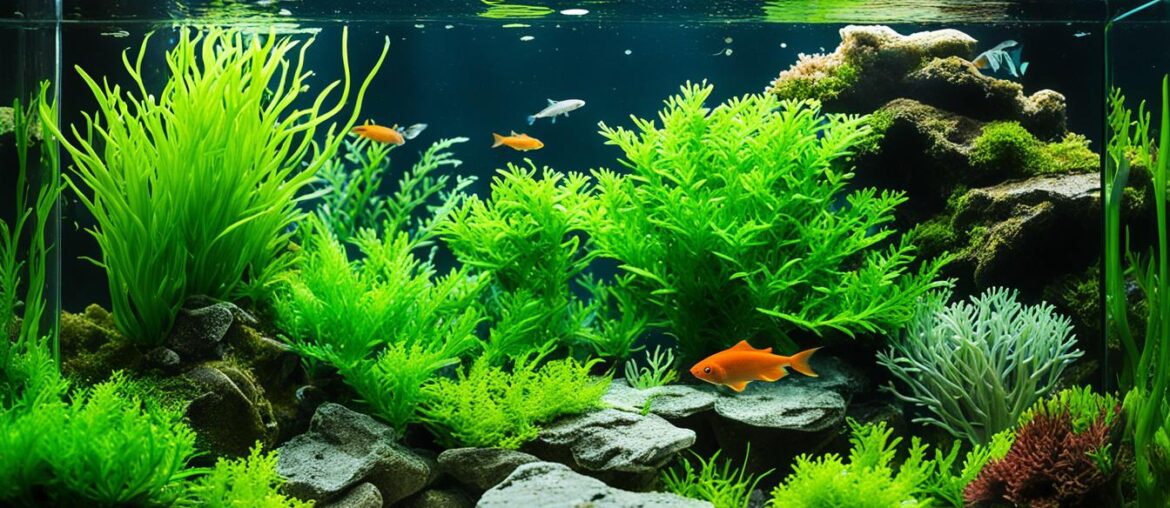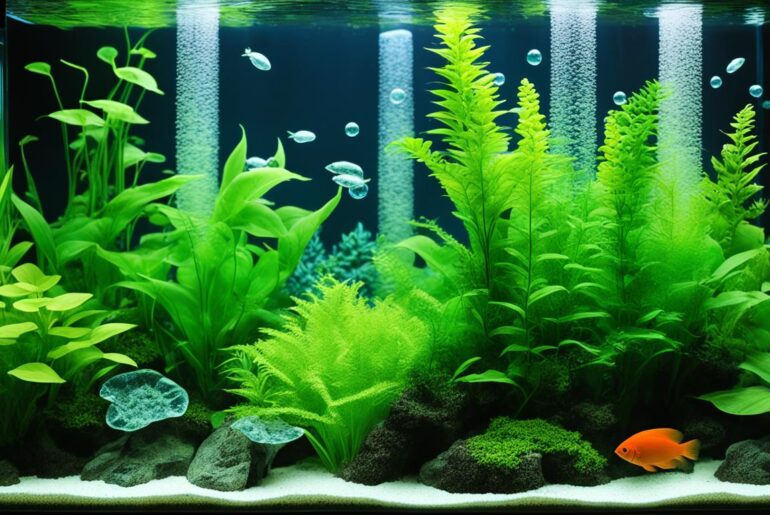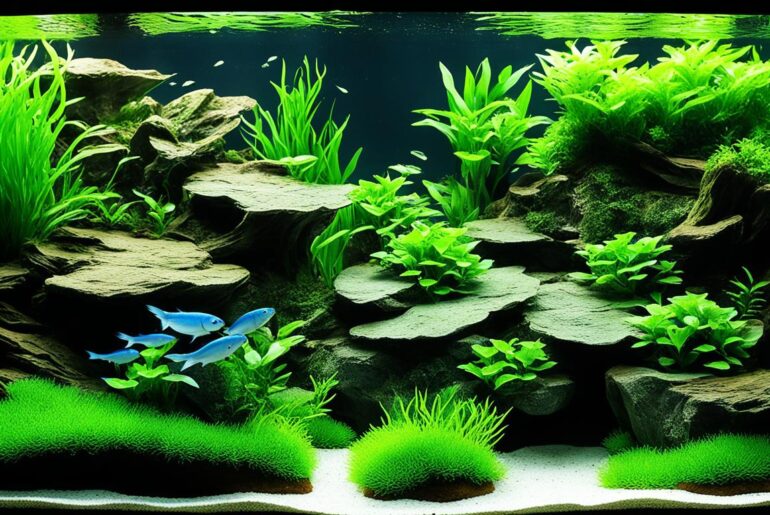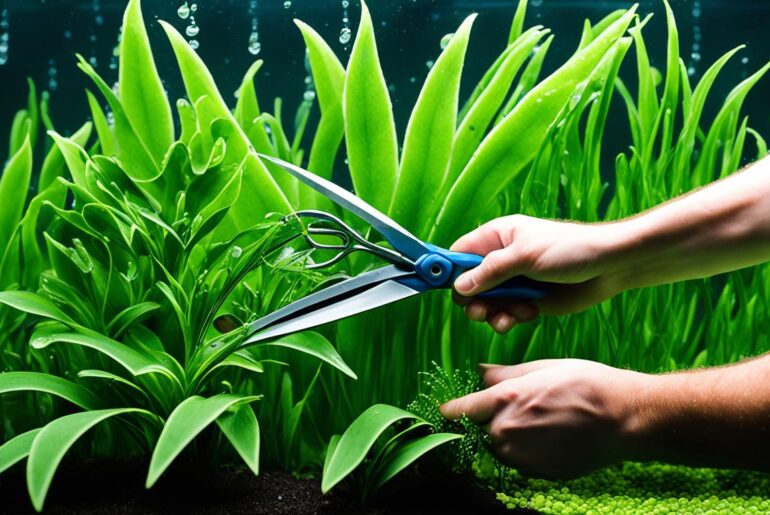Imagine stepping into a room filled with vibrant colors, serene beauty, and a sense of tranquility. That’s exactly what I experience every time I gaze at my meticulously maintained planted aquarium. It has become more than just a hobby for me; it’s a form of therapy, a way to escape the stresses of everyday life.
But there was a time when my aquarium wasn’t the serene paradise I had envisioned. Algae growth had taken over, suffocating my plants and sapping the life out of my underwater oasis. It was disheartening to see my once thriving aquarium succumb to the invasive green menace.
It took me a while to realize that algae control is not just about aesthetics; it’s about preserving the delicate balance of life within your aquarium. As I embarked on a journey to regain control over my aquatic haven, I discovered some invaluable tips and techniques that are worth sharing.
Key Takeaways:
- Controlling algae growth is essential for maintaining a healthy and visually appealing planted aquarium.
- Regulate feeding to prevent excess nutrients that promote algae growth.
- Manage lighting to ensure the proper balance for your plants and minimize algae growth.
- Regular water changes are crucial for removing excess nutrients and preventing algae outbreaks.
- Test your tap water for algae-inducing elements before water changes.
Regulate Feeding to Prevent Algae Growth
One of the key factors in reducing algae growth in planted aquariums is to regulate feeding. Overfeeding is a common source of excess nutrients that promote algae growth, such as ammonia and phosphate. By ensuring that your fish consume all the food within a couple of minutes, you can minimize the nutrients available for algae to thrive on.
Feeding your fish sparingly is essential in controlling algae growth. Avoid excessive feeding, as it can lead to an accumulation of uneaten food and an increase in nutrient levels. By following a strict feeding routine and providing only the necessary amount of food, you can create an environment that is less favorable for algae growth.
When feeding, observe your fish closely to ensure they consume all the food. If you notice that there is uneaten food remaining after a few minutes, it is a sign that you are overfeeding. Adjust the amount of food accordingly to prevent excess nutrients from entering the aquarium.
Remember, a balanced and controlled diet for your fish not only promotes their health but also helps to reduce the nutrients available for algae. By regulating feeding and avoiding overfeeding, you can effectively manage and control algae growth in your planted aquarium.
| Benefits of Regulating Feeding for Algae Control |
|---|
| Reduces excess nutrients: Controlling feeding helps minimize the accumulation of ammonia and phosphate, which are nutrients that algae thrive on. |
| Promotes a balanced ecosystem: By ensuring fish consume all the food, you create a healthier and more balanced aquarium environment. |
| Prevents algae outbreaks: Avoiding overfeeding prevents the proliferation of algae, maintaining the visual appeal of your planted aquarium. |
Manage Lighting for Algae Control
The lighting in your aquarium plays a crucial role in controlling algae growth. Extended light cycles can contribute to excessive algae growth, leading to unsightly outbreaks in your planted tanks. To prevent this, it is important to implement effective lighting management techniques.
One recommended approach is to put your aquarium lights on a timer, replicating a natural day/night schedule. By keeping the lights on for 10-14 hours per day, you can provide enough light for your plants to thrive while minimizing the opportunities for algae to flourish.
Another important consideration is the age of your light bulbs. Aged bulbs can emit wavelengths that promote algae growth. Therefore, it is advisable to change your bulbs at least once a year to ensure optimum lighting conditions for your plants and prevent algae outbreaks.
To summarize, managing lighting in your planted tanks is essential for algae control. By using timers to regulate light cycles and replacing bulbs regularly, you can create an environment that fosters healthy plant growth while minimizing the risk of algae infestation.
Benefits of managing lighting for algae control:
- Prevents excessive algae growth
- Provides optimal lighting conditions for plant growth
- Reduces the risk of algae outbreaks in your planted tanks
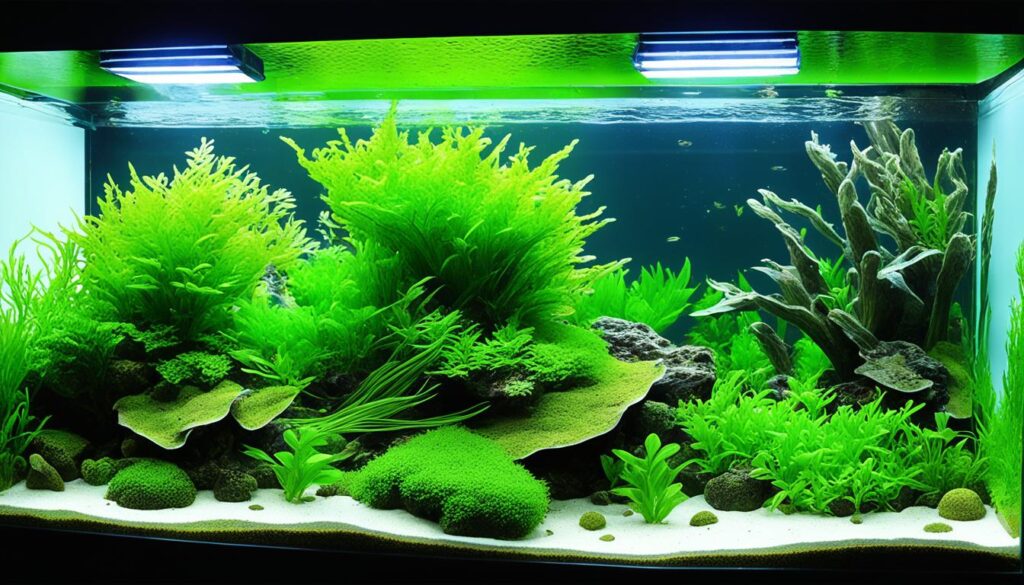
Regular Water Changes for Algae Prevention
Regular water changes are essential for preventing algae outbreaks in planted aquariums. In nature, rain and water currents refresh water conditions, diluting and carrying away nutrients that algae thrive on. However, in a closed aquarium system, these natural processes are absent, making regular water changes necessary to maintain a healthy balance and control algae growth.
Performing regular water changes helps remove excess nutrients that can fuel algae growth. By replacing a portion of the aquarium water, you effectively dilute the nutrient concentration, making it less favorable for algae to thrive. This simple yet effective practice is one of the key Algae Control tips for aquascaping success.
So, what is the ideal frequency for water changes in your planted aquarium? A general guideline is to perform a 10% water change weekly or a 30% water change monthly for lightly populated aquariums. Adjust the frequency based on your specific setup and the needs of your aquatic plants and fish.
Regular water changes offer additional benefits beyond Algae Control. They also provide an opportunity to remove sludge and debris that can accumulate in the aquarium. This reduces the nutrient load and prevents the buildup of potential pollutants that could harm your plants and fish.
To ensure the success of your regular water changes, follow these steps:
- Prepare the water: Use a water conditioner to remove chlorine, chloramines, and heavy metals from tap water. This ensures that the newly added water is safe for your aquarium inhabitants.
- Use temperature-matched water: Prior to performing a water change, make sure the replacement water is of the same temperature as the aquarium water. Sudden temperature fluctuations can stress your fish and plants.
- Siphon the substrate: During water changes, siphon the substrate gently to remove any debris or mulm that may have settled. This helps maintain a clean and healthy environment for your aquarium plants.
- Replace the water: Gradually add the new water to the aquarium, taking care not to disturb the plants and fish. Slowly pouring the water over your hand or using a diffuser can help minimize turbulence.
Regular water changes not only prevent algae outbreaks but also contribute to the overall health and beauty of your aquascape. By diligently maintaining the water quality in your aquarium, you can create an environment that promotes the successful growth of your aquatic plants and keeps algae at bay.
I invite you to explore other sections of this article to discover more Algae Control techniques and tips for achieving aquascaping success.
Test Tap Water for Algae-Inducing Elements
Tap water can contain elements that encourage algae growth in your aquarium. Testing your tap water for significant levels of phosphate or other algae-inducing elements is an important step in algae control. By identifying the presence of these elements, you can take appropriate measures to reduce their impact on your planted aquarium.
Before performing water changes, it is recommended to test your tap water using an aquarium water test kit. This will provide valuable insights into the quality of your tap water and help you determine if any adjustments are necessary.
If test results show high levels of phosphate or other algae-inducing elements, your battle against algae through water changes alone will be ineffective. In such cases, you may need to consider alternative methods, such as using an RO (reverse osmosis) unit or a tap water filter, to reduce these elements before adding water to your aquarium.
Testing tap water before making changes to your aquarium ensures that you are not introducing additional nutrients that could contribute to algae growth. By addressing the root cause of algae-inducing elements in your tap water, you can significantly improve the health and appearance of your aquarium plants.
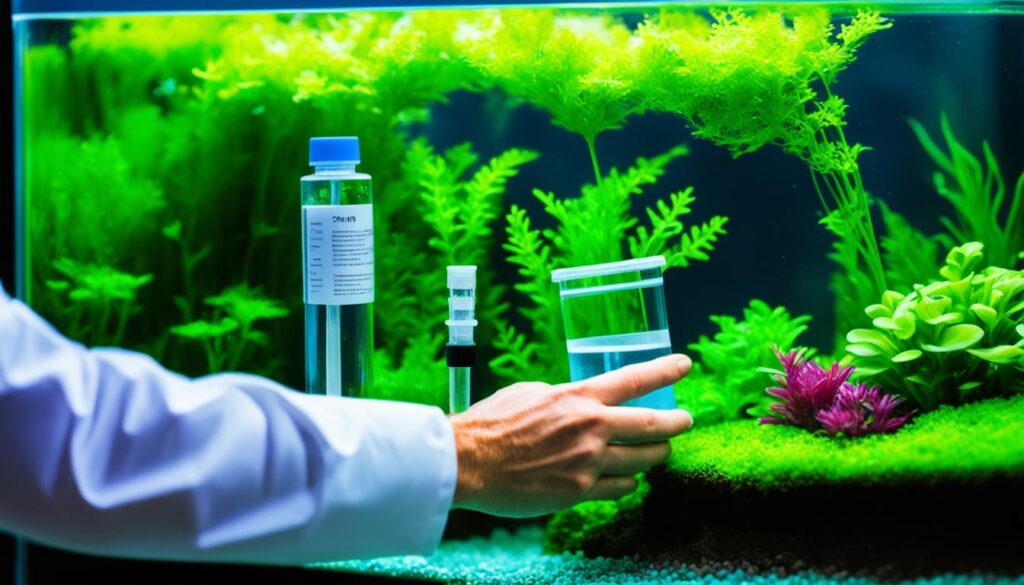
Maintain Filter Media for Algae Prevention
Proper maintenance of filter media is crucial for preventing algae growth in your planted aquarium. By using the right Algae Control products for planted aquariums and implementing effective Algae Control techniques, you can ensure that your filter system is working optimally to keep algae at bay.
One of the key components in maintaining filter media is using phosphate-controlling media and biological boosters. Phosphate is a nutrient that algae thrive on, so by controlling its levels in the water, you can minimize the risk of algae outbreaks. Using products specifically designed for Algae Control, such as phosphate-removing filter media, can help keep algae’s favorite nutrient out of your aquarium.
Regular replacement of mechanical and chemical media is also essential. Over time, these media can become clogged or exhausted, reducing their ability to effectively remove phosphates and other nutrients that contribute to algae growth. By replacing them at the recommended intervals, usually every 3-6 months, you can maintain optimal filtration and ensure that algae-promoting nutrients do not leach back into your aquarium.
Here is a table showcasing some popular filter media options for Algae Control in planted aquariums:
| Filter Media | Description |
|---|---|
| Activated Carbon | Absorbs organic compounds and chemicals that can contribute to algae growth. |
| GFO (Granular Ferric Oxide) | Specifically targets phosphate, effectively reducing its levels in the water. |
| Bio Balls | Provide a large surface area for beneficial bacteria to colonize and help break down organic waste. |
By maintaining your filter media and utilizing effective Algae Control products for planted aquariums, you can create an environment that is unfavorable for algae growth. Remember to follow the manufacturer’s recommendations for the specific products you are using and monitor water parameters to ensure they are within the appropriate range for a healthy planted aquarium.
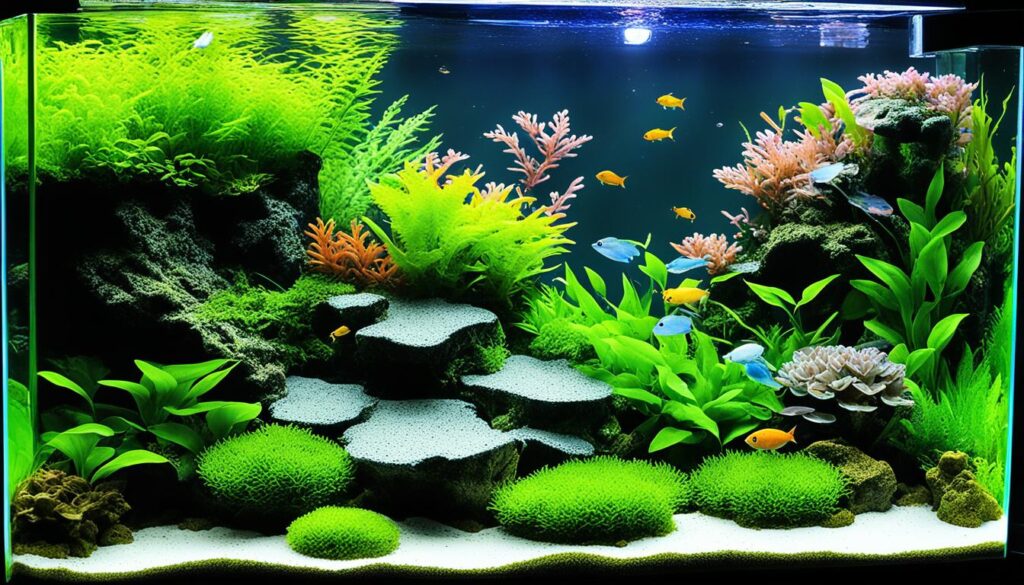
“Proper maintenance of filter media is crucial for preventing algae growth.”
Use Suitable Scrapers for Algae Removal
Algae can quickly turn your clear aquarium glass into a green mess. To keep your tank looking pristine, it’s important to have the right tools for algae removal. One effective tool is the Two Little Fishies NanoMag, a suitable scraper specifically designed for removing algae from glass surfaces. This compact and ergonomic scraper provides excellent maneuverability, making it easy to reach those hard-to-access areas in your aquarium.
But algae can also cling to other surfaces in your tank, such as fixtures, decorations, pumps, and other aquarium accessories. For complete algae control, there are various products available that specifically target these surfaces. From soft brushes to specialized scrubbers, these tools are designed to effectively remove algae without causing damage to your aquarium.
Having the right scrapers and tools on hand is essential for efficient and hassle-free algae removal. With the right equipment, you can easily maintain a clean and visually appealing aquarium environment.

Harness the Power of Plants to Control Algae
Planted aquariums can benefit significantly from the presence of live plants in controlling algae growth. When it comes to algae control, plants act as natural competitors for light and nutrients, often outcompeting algae if given the proper conditions. By incorporating a diverse range of plants in your aquarium, you can create an environment that minimizes the chances of algae takeover.
The more plants you have in your aquarium, the better equipped they are to maintain a healthy balance and prevent excessive algae growth. These plants absorb nutrients like nitrates and phosphates, robbing algae of the essential elements required for their growth. Additionally, the shade provided by the plants can also limit the amount of light that reaches the algae, further impeding their growth.
Consider adding beneficial macro algae, such as the popular Chaetomorpha, to marine aquariums. These algae can be placed within a connected refugium or sump filter, where they actively absorb excess nutrients and compete with unwanted algae. Macro algae can be a valuable addition to your algae control strategy, enhancing the overall health and stability of your marine ecosystem.
When selecting plants for your aquarium, it’s important to choose species that are compatible with the specific conditions of your tank, such as lighting, water parameters, and substrate. Research species that are known for their effective algae-controlling properties and consider their growth habits and maintenance requirements.
By harnessing the power of plants, you can create a natural and harmonious environment that promotes the healthy growth of aquarium plants while discouraging algae overgrowth.
| Benefits | Description |
|---|---|
| Competition for Nutrients | Plants compete with algae for essential nutrients like nitrates and phosphates, limiting the availability of these nutrients for algae. |
| Shade and Light Control | The presence of plants provides shade, reducing the amount of light that reaches the algae and inhibiting their growth. |
| Natural Filtration | Plants act as natural filters, absorbing pollutants like ammonia and nitrites, which would otherwise contribute to algae growth. |
| Ecosystem Stability | Aquariums with a diverse range of plants tend to have a more stable and balanced ecosystem, reducing the likelihood of algae outbreaks. |
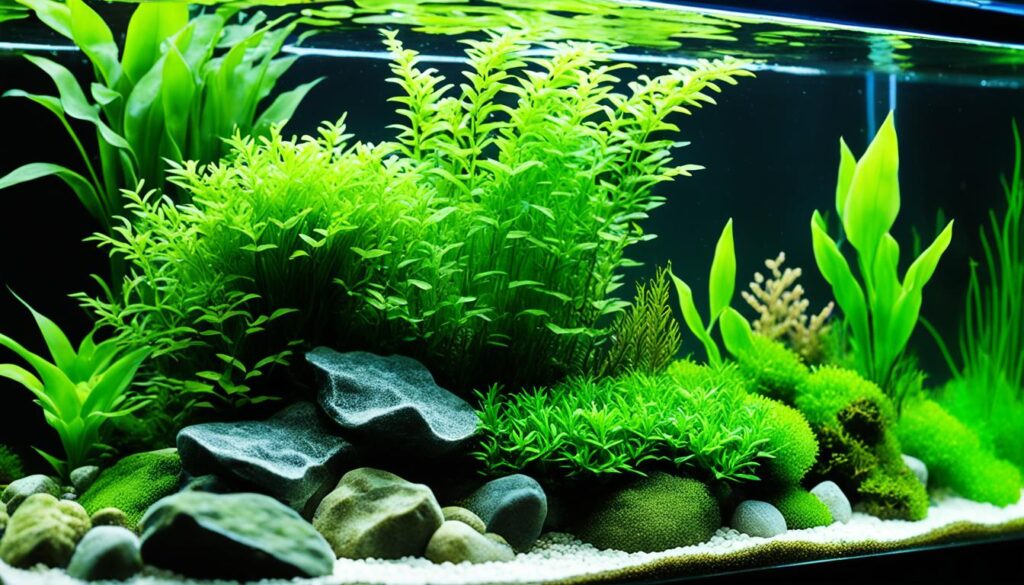
Utilize Algae-Eating Fish for Algae Control
Introducing fish that eat algae can be a game-changer when it comes to controlling algae growth in your planted aquarium. These little helpers are natural Algae Control products for planted aquariums, as they constantly forage for algae on plants and structures, helping to keep it in check. There are a few options available, depending on the size and type of aquarium.
Dwarf Otocinclus Catfish
The Dwarf Otocinclus Catfish is a suitable option for smaller tanks. These hardy fish are known for their appetite for algae and can make a significant impact on its growth. They are not picky eaters and will diligently search for algae on various surfaces, keeping your aquarium clean and vibrant.
Cory Catfish
If you have a larger aquarium, the Cory Catfish is another excellent choice. These bottom-dwelling fish patrol the substrate, consuming excess fish food before it can decompose and contribute to ammonia and nitrite levels. Their constant nibbling helps prevent algae from thriving and maintains a healthy ecosystem for your aquatic plants.
Reef Cleaner Packs for Marine Aquariums
If you have a marine aquarium, Reef Cleaner Packs can provide an effective solution for controlling algae. These convenient packs typically include various species of snails, crabs, and hermit crabs that feed on algae, detritus, and other organic waste. These natural Algae Control methods can help keep your marine aquarium clean and thriving.
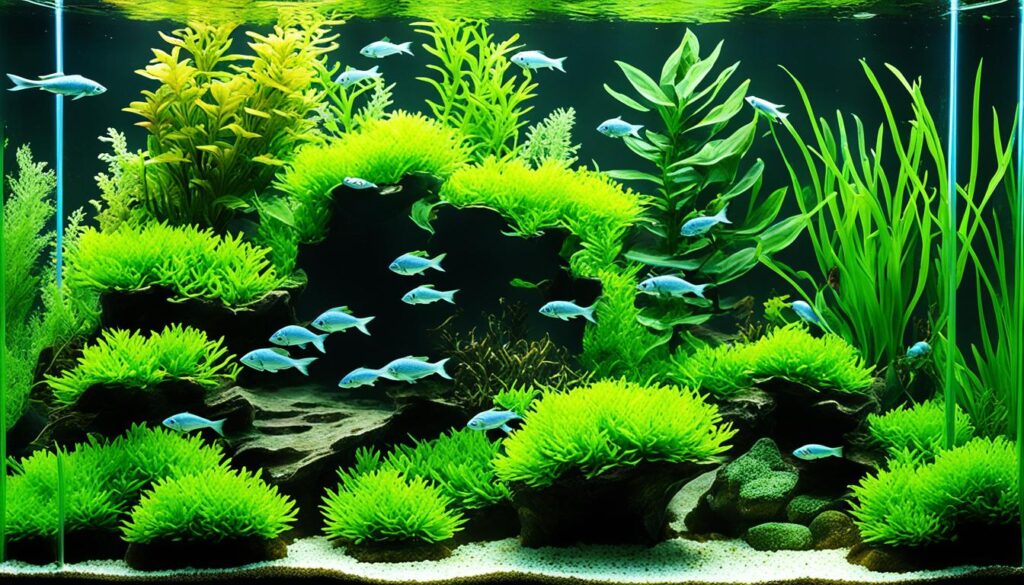
Incorporating algae-eating fish into your aquarium can be a great addition to your Algae Control methods. They provide a natural and effective way to keep algae growth in check, reducing the need for harsh chemicals or excessive manual cleaning. Remember to consider the needs of your specific aquarium and choose fish that are compatible with the other inhabitants. With the help of these fish, you can enjoy a healthy and visually appealing planted aquarium free from the frustrations of algae overgrowth.
Conclusion
Controlling algae is essential for maintaining the health and beauty of your planted aquarium. By implementing these 10 effective tips, you can create a thriving environment for your aquarium plants while preventing algae outbreaks in planted tanks.
Regulating feeding and managing lighting are crucial steps in reducing algae growth. By avoiding overfeeding and using timers to control lighting cycles, you can minimize the nutrients that algae thrive on. Additionally, performing regular water changes not only dilutes nutrients but also removes sludge and dead plant matter that contribute to algae growth.
Testing your tap water for algae-inducing elements is another important step to prevent additional nutrients from entering your aquarium. Maintaining filter media and using suitable scrapers can further control algae growth by reducing phosphate levels and removing algae from surfaces. Harnessing the power of plants and utilizing algae-eating fish offer natural solutions for algae control in planted aquariums.
Remember, maintaining a natural balance in your enclosed ecosystem is key to successfully combating algae. By following these tips, you can create an algae-free environment in your planted aquarium and enjoy a visually stunning and healthy underwater world.
FAQ
How can I regulate feeding to prevent algae growth in my planted aquarium?
To regulate feeding and minimize nutrients available for algae growth, feed your fish sparingly, ensuring they consume all the food within a couple of minutes.
How can I manage lighting to control algae growth in my aquarium?
To control algae, put your lights on a timer to replicate a day/night schedule and keep them on for 10-14 hours per day. Additionally, change bulbs at least once a year to avoid promoting algae growth.
How often should I perform water changes to prevent algae outbreaks?
It is recommended to do a 10% weekly water change or a 30% monthly water change for lightly populated aquariums to remove excess nutrients and prevent algae outbreaks.
Why is it important to test tap water for algae-inducing elements before performing water changes?
Tap water can contain elements that encourage algae growth. Testing your tap water for significant levels of phosphate or other algae-inducing elements ensures that you are not introducing additional nutrients that could contribute to algae growth in your planted aquarium.
How can maintaining filter media help prevent algae growth in my aquarium?
By using phosphate-controlling media and regularly replacing mechanical and chemical media in your filtration system, you can reduce phosphate levels and prevent algae outbreaks.
What tools can I use to remove algae from glass surfaces in my aquarium?
Suitable scrapers like the Two Little Fishies NanoMag can help remove algae from glass surfaces in your aquarium. Additionally, there are products available for removing algae from fixtures, decorations, pumps, and other aquarium accessories.
How can I harness the power of plants to control algae growth in my aquarium?
Plants compete with algae for light and nutrients. By having more plants in your aquarium, you reduce the chances of algae taking over. Consider incorporating beneficial macro algae, such as Chaetomorpha, in marine aquariums placed within a connected refugium or sump filter for additional algae control.
What are some algae-eating fish that I can introduce to control algae growth in my planted aquarium?
Dwarf Otocinclus Catfish and Cory Catfish are suitable options as they constantly forage for algae on plants and structures. For marine aquariums, Reef Cleaner Packs provide a natural and effective solution for controlling algae.
How can I effectively control algae growth in my planted aquarium?
By implementing these tips, such as regulating feeding, managing lighting, performing regular water changes, testing tap water, maintaining filter media, using suitable scrapers, harnessing the power of plants, and utilizing algae-eating fish, you can effectively control algae growth and create a thriving environment for your aquarium plants.
